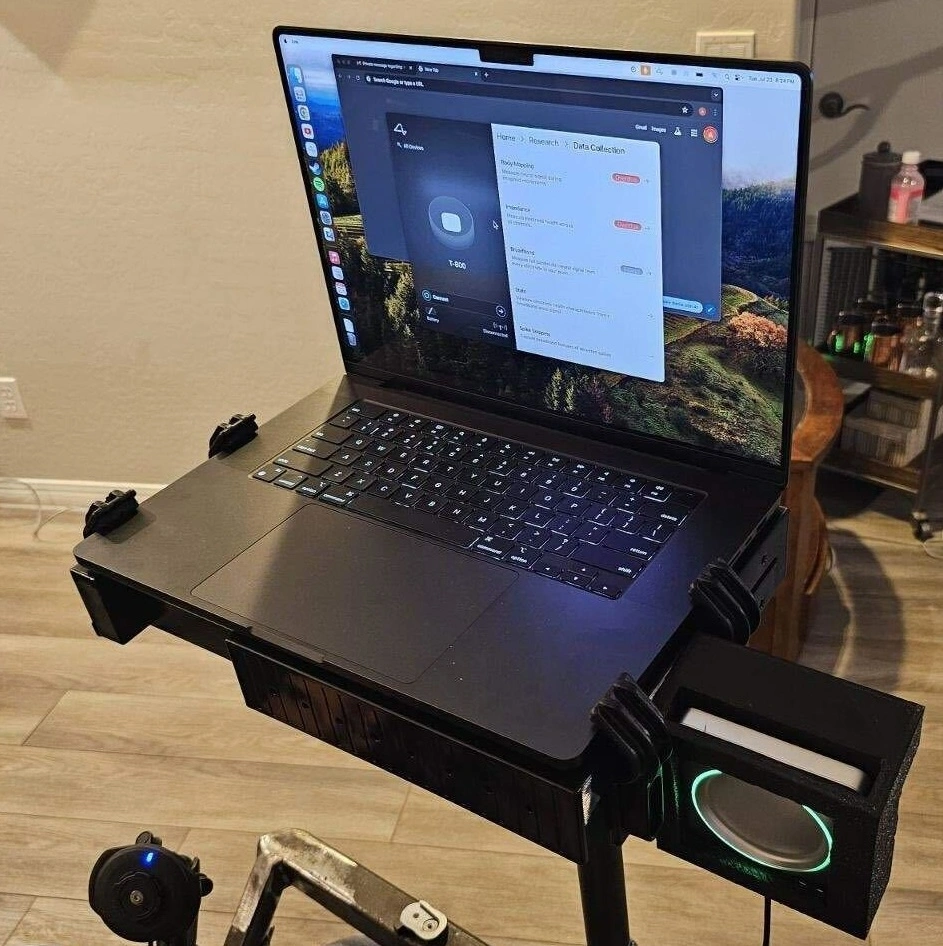Last month, Alex,* the second participant in our PRIME Study,** received his Neuralink implant (Link). The surgery, conducted at the Barrow Neurological Institute, went well — Alex was discharged the following day, and his recovery has been smooth. With the Link, he has been improving his ability to play video games and began learning how to use computer-aided design (CAD) software to design 3D objects. This marks another significant step towards providing a high-performance interface that will enhance the control of digital devices for people with quadriplegia to help restore their autonomy.
The overarching aim for the PRIME Study is to demonstrate that the Link is safe and useful in daily life, as noted in our last blog post. In this blog post, we share updates from the experience of our second participant across three key dimensions that support this aim:
- Out-of-the-box experience
- Repertoire of capabilities
- Thread retraction mitigations
Out-of-the-Box Experience
From the first moment Alex connected his Link to his computer, it took less than 5 minutes for him to start controlling a cursor with his mind. Within a few hours, he was able to surpass the maximum speed and accuracy he’d achieved with any other assistive technology on our Webgrid task. Similar to Noland, our first participant, Alex broke the previous world record for brain-computer interface (BCI) cursor control with a non-Neuralink device on day one of using the Link. After the first research session concluded, Alex continued testing the capabilities of the Link independently, using it to play the first-person shooter game Counter-Strike.
“I’m already super impressed with how this works.”
— Alex, PRIME Study participant
(Fig 01)
Alex using the Link to play Webgrid.
Repertoire of Capabilities
Alex enjoys building things. Before his spinal cord injury, he worked as an automotive technician, fixing and tinkering with various types of vehicles and large machinery. Since then, he has wanted to learn how to design 3D objects using computer-aided design (CAD) software so he could work on projects without needing to rely extensively on his support system. However, the level of control offered by his assistive technologies made this challenging.
On day two of using the Link, Alex used the CAD software Fusion 360 for the first time and managed to design a custom mount for his Neuralink charger, which was then 3D printed and integrated into his setup. We are working with Alex to increase his productivity with the Link by mapping intended movements to different types of mouse clicks (e.g., left, right, middle), thereby expanding the number of controls he has and enabling him to quickly switch between various modes in CAD software (e.g., zoom, scroll, pan, click-and-drag).
In his free time, Alex continues to use CAD software to turn his design ideas into reality. We hope that in time, the Link helps many people create in their areas of interest and expertise, and we’re excited to work with more people to help them reconnect with their passions.
“Taking an idea, putting it as a design, and actually having a physical item as a finished product makes me feel like I’m building things again.”
— Alex, PRIME Study participant
(Fig 02)
In this video, Alex uses his Link to carve out the center of the custom mount for his Neuralink charger (finished product shown in Fig 03). On the right side of his screen is a mode switcher — a user interface element developed by Neuralink — which he leverages to quickly change the functionality of his mouse.

(Fig 03)
To the right of Alex’s laptop is a 3D-printed charger mount that he designed using his Link.
Alex also enjoys playing first-person shooter games, which generally require the use of numerous inputs, including two separate joysticks (one for aiming and the other for moving) and an array of buttons. Before receiving the Link, Alex enjoyed playing these games using an assistive device called the Quadstick — a mouth operated joystick with sip-and-puff pressure sensors and a lip position sensor for clicking. However, a key limitation of the controller is that it only has one joystick, restricting Alex to either moving or aiming at any given time. Switching from moving to aiming involves letting go of the joystick and then sipping or puffing into a separate straw to toggle the functionality. Now, Alex is able to use the Link in combination with his Quadstick to move and aim simultaneously, unlocking a more intuitive gameplay experience.
“Just running around is so enjoyable because I can look side to side, and not need to move Quadstick left and right… I can [think about where to] look and it goes where I want it to. It’s insane.”
— Alex, PRIME Study participant
(Fig 04)
Alex playing Counter-Strike.
Thread Retraction Mitigations
With our first participant, Noland, we observed a degree of thread retraction that temporarily reduced his BCI performance. The threads have stabilized, and the performance of Noland’s Link has since recovered — more than doubling the prior world record for BCI cursor control.
To reduce the probability of thread retraction in our second participant, we implemented a number of mitigations, including reducing brain motion during the surgery and reducing the gap between the implant and the surface of the brain. We discussed these measures in greater detail in our live update prior to our second participant’s surgery.
Promisingly, we have observed no thread retraction in our second participant.
Looking Forward
To further enhance our participants’ experience using their digital devices, we are continuing to expand the controls that are available to them. We are working on decoding multiple clicks and multiple simultaneous movement intents to deliver full mouse and video game controller functionality. We are also developing algorithms to recognize handwriting intent to enable faster text entry. These capabilities would not only help restore digital autonomy for those who are unable to use their limbs, but also restore the ability to communicate for those who are unable to speak, such as people with neurological conditions like amyotrophic lateral sclerosis (ALS).
Additionally, we plan to enable the Link to interact with the physical world, allowing users to feed themselves and move more independently by controlling a robotic arm or their wheelchair.
“The Link is a big step on the path of regaining freedom and independence for myself.”
— Alex, PRIME Study participant
Join the Neuralink Community
If you are excited to restore autonomy to those with unmet medical needs, consider applying to our open roles. If you are interested in shaping the future of assistive technologies by participating in a Neuralink clinical trial, please join our Patient Registry.
* Name shared at the request of the participant.
** The PRIME Study — an investigational medical device trial for our fully implantable, wireless brain-computer interface (BCI) — aims to evaluate the safety of our implant and surgical robot, and assess the initial functionality of our BCI for enabling people with quadriplegia to control external devices with their thoughts. We do not guarantee any benefit by participating in the PRIME Study.
